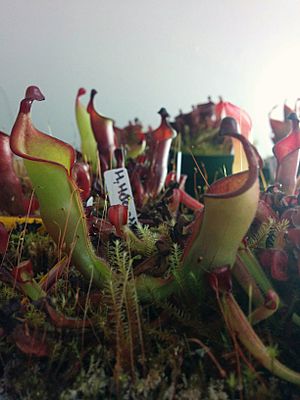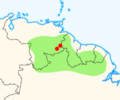Heliamphora heterodoxa facts for kids
Quick facts for kids Heliamphora heterodoxa |
|
|---|---|
 |
|
| Heliamphora heterodoxa in cultivation | |
| Scientific classification | |
| Genus: |
Heliamphora
|
| Species: |
heterodoxa
|
 |
|
| Native range | |
| Synonyms | |
|
|
Heliamphora heterodoxa is a special type of marsh pitcher plant. It gets its name from Greek words meaning "other" and "belief," because it can look quite different from one plant to another.
This unique plant grows naturally in Venezuela and nearby Guyana. Scientists first found it in 1944. It was growing on the slopes between two mountains called Ptari-tepui and Sororopan-tepui. It was officially named in 1951.
Heliamphora heterodoxa is closely related to another pitcher plant, H. glabra. For a long time, people thought H. glabra was just a different version of H. heterodoxa. This plant was one of four Heliamphora species first described by a scientist named Julian A. Steyermark.
Unlike some other pitcher plants, Heliamphora heterodoxa can handle slightly warmer temperatures. This is because it lives in higher wetlands, about 1200 to 1500 meters above sea level. It grows very well and has a big, overhanging part called a nectar spoon. This spoon helps to attract insects.
What's in a Name?
The name "heterodoxa" means "variable." The scientist J.A. Steyermark gave it this name. He noticed that these plants could look quite different from each other.
In May 2018, an expedition went to the place where H. heterodoxa was first found. This was on the southwestern slopes of Ptari-tepui. They found other pitcher plants there too. These included H. collina and a mix of H. collina and H. purpurascens plants. This showed just how much variety can be found in one spot!
Images for kids
See also
 In Spanish: Heliamphora heterodoxa para niños
In Spanish: Heliamphora heterodoxa para niños


